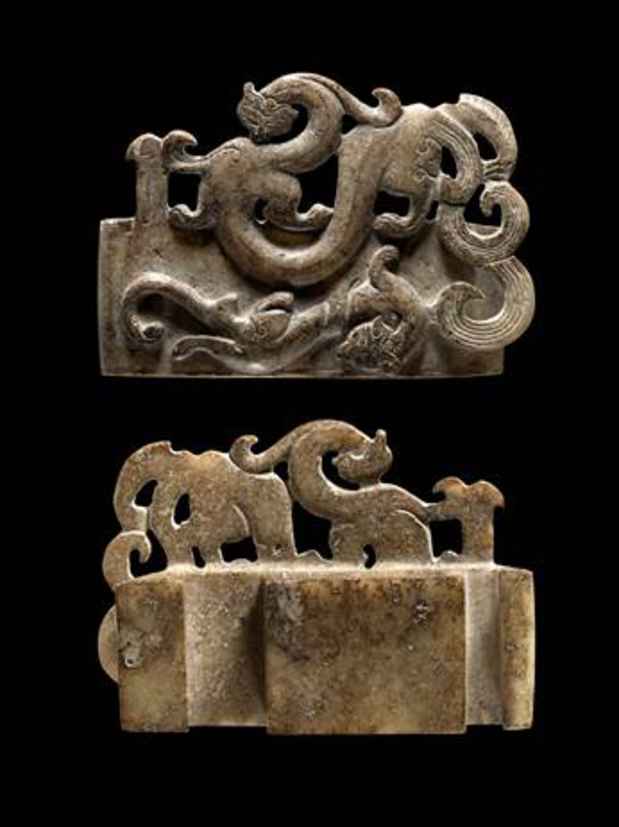“The Beauty of Jade during the Warring States and Early Han Periods” Exhibition
Throckmorton Fine Art

This event has ended.
Throckmorton Fine Art presents an important exhibition of ancient Chinese jade created during the first high age in their development, from the 7th century BC, during the Warring States era, to the 2nd century BC, under the Early Han Dynasty.
Chinese jade scholars Dr. Elizabeth Childs-Johnson and Gu Fang have each contributed to the preparation of a detailed brochure and descriptions for “The Beauty of Jade during the Warring States and Early Han Periods” show, which includes more than 73 pieces on view.
Dr. Elizabeth Childs-Johnson has curated many shows of ancient Chinese art at Throckmorton for more than a decade, and has collaborated with Gu Fang on numerous catalogues including “Chinese Jade Types of the Shang and Western Zhou Periods.”
According to Spencer Throckmorton, “The artistic explosion that took place during the Warring States and Han periods is now being re-examined as interest has soared in learning more about the art of working jade during the early years. It was then that social and economic upheaval led to cross-cultural stimulation and an interchange of artistic media that climaxed in new artistic themes and combinations of images.”
As the eminent art historian Michael Sullivan stated, “[The] power to unite in one object the most intricate refinement of detail with a dynamic rhythm and boldness of silhouette defines jade art at this time in early Chinese history. The variations on the feline dragon dramatically express this refinement and combustible calligraphic style. The movement and form of the serpent are limitless: they may circle, change direction, intertwine, dance, surprise, bite their tail, spring, or leap yet never sleep. Refined detail is similarly wide in range, from rope and scale textures to erupting miniscule bas-relief cloud scrolls.”
In his essay for the show catalogue, the renowned jade scholar Gu Fang says, “From the Warring States era to the early Han Dynasty (7th Century BC – 2nd Century BC), China experienced its first high age in the development of ancient jades. The scale and quality of jade production reached an unprecedented level. Thus, jade connoisseurs all take pride in beautiful pieces of Warring States to Han Dynasty jades in their collection.”
Actually, the development of jade in China had come a long way from the Neolithic Age to the Han Dynasty. The beauty of the jades from the Warring States era to Han Dynasty, is not spontaneous, but a result of thousands of years of development.
Among highlights in the Throckmorton exhibition is a Jade disc with grain design, aa dragon with a cloud design, a jade vessel or zun also with cloud design, an animal mask, a sword pommel with feline design, a tiger-shaped pendant, a tubular pendant, an agate belt ring and numerous jade pendants.
Gu Fang says that the differences in wealth led to the varied quality and quantity of jade accessories, which were the most popular form, including a wide array of half rings for the head, usually worn on the ears. Jades hanging from the neck and waist were the most important accessories while people took the jade pendants hanging outside of clothes as the most beloved accessories, and saw them as symbols of longevity and luxurious gifts. Often jade pieces were matched together in elaborate “group sets,” Gu Fang says.
Between the Warring States era to the Han Dynasty jade sets became more simplified with important elements comprised of bi, huang, huan, xi and chong connected with a ribbon often decorated with beads and tubes.
Jade was a symbol of class and wealth as well as an expression of virtues. People paid the most attention to clothing accessories. Jade pendants were intricate in form and carving work and many distinctive shapes were seen from circular, horn-shaped and squared forms to “S” shaped or double “S’s.” Jade was carved into dragon shapes resembling a tiger, often in relief or open carving and positioned in a resting or climbing pose. They were used to decorate jade discs, swords and stamps. The ancient Chinese imagined the chi tiger to be able to cruise into the heavens, this when making the chi tiger patterns, clouds were often added to the background.
The jades from the Warring States era to Han Dynasty were mostly decorated with complex patterns. These patterns are rich in styles and complexity. The depiction is highly abstract, which gives off what Gu Fang calls, a mysterious vibe. These patterns fall into two main categories, geometric and animal-form, with geometric patterns being the dominant one.
Media
Schedule
from March 05, 2015 to April 04, 2015